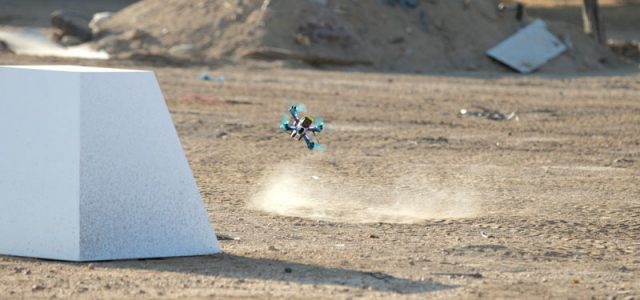Setting up a single, highly competitive first-person-view (FPV) race is a lot of work. You need a location and a course setup, and you need to get the word out to competitors. Then you need to pull together your crew, lay down the rules, and get the video signals locked in so that each pilot has a clear view. Now try doing that in six locations around the globe while coordinating travel plans for five top drone-racing teams! Oh, and you also need to film all of the action for broadcast television. This is the daunting task that the DR1 Racing League has taken on to bring you its DHL Champions Series of drone racing.
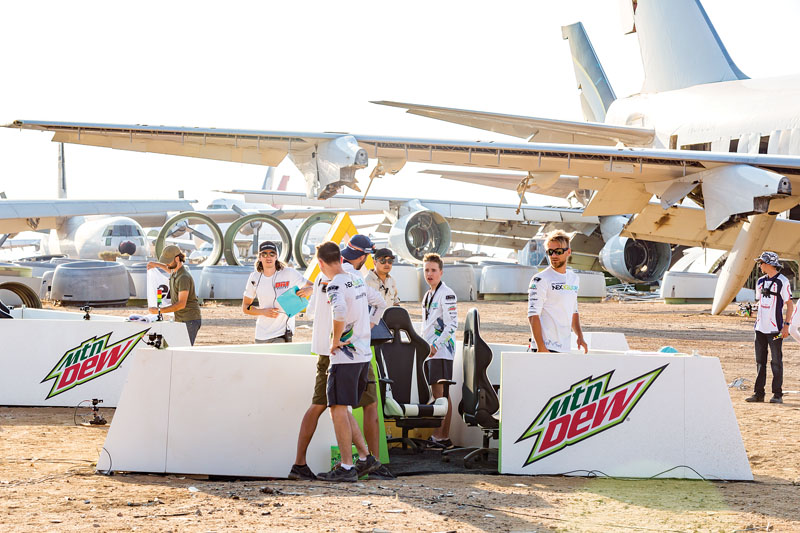
Team NEXXBlades gets set up for the next heat
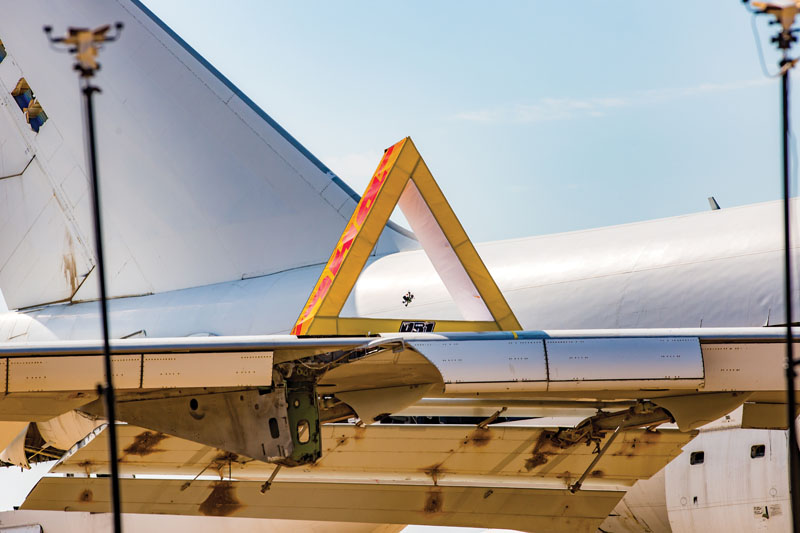
Over the top of the wing and through the gate!
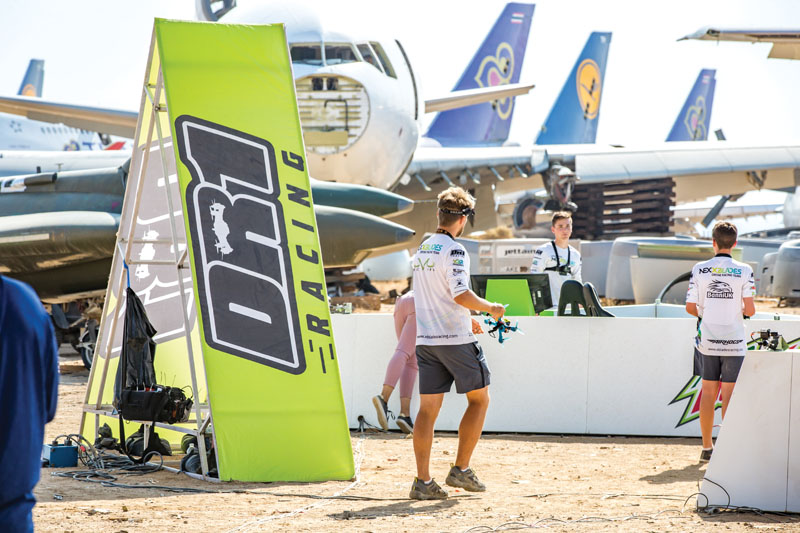
After the heat, a team member from NEXXBlades picks up the drone that made it back.
When we asked Brad Foxhoven, founder and CEO of DR1, why the group decided to create this type of racing series, he said, “We wanted to create the most epic drone-racing series in the world, and to do so, we needed to find outdoor locations that captured the spirit, excitement, and adrenaline of flying a drone. We also wanted to incorporate a team-based format that included a pit stop. In this series, there are three pilots on a team, with two pilots flying in the heat and the third pilot acting as their spotter and lead in the pit. That third pilot is responsible for helping manage the race as well as changing the batteries of the racing drones when they land. What this does is create a sense of camaraderie between the pilots on the team and insert a lot more strategy into the way the team approaches each race. So now they have to not only navigate these amazing racecourses but also work as a team to win.”
The races take place in six locations. The first two races are in Southern California at the Trona Pinnacles near Death Valley. Rising from the cracked earth are pillars of rock up to 200 feet tall, offering up a unique racecourse. The crew then travels to the Mojave Boneyard, where ominous steel skeletons of old aircraft provide another unique racecourse. The troop then packs it up for some overseas travel to the next location: the DHL Tower in Bonn, Germany, where the racing drones dive down 533 feet to the finish line. Those who make it through the halfway point earn a badge of honor. Now it’s time to move to Spike Island, Ireland, a sixth-century monastery that was a prison in Victorian times. Here, pilots race through the halls where monks and convicts used to sit. Next comes a short hop to Bunowen Castle in Galway, Ireland, where the crew films as five teams pilot their drones down a sheer rock cliff and skirt along a raging ocean to be the first to cross the finish line. The final stop of this grueling adventure is the Championship Race on the Isle of Man. Cast and crew will be exhausted by the time the flag is dropped for this event, but the teams will still have to navigate giant cliffs as they dive off them in a quest for victory.
Because each location is so vastly different, we asked Brad if some were more difficult to plan for. He notes, “Each location was completely unique and came with its own set of challenges. We dealt with extreme heat, sandstorms, gale-force wind, and rain as well as the logistical difficulty of having a tech-driven event in remote locations around the world with little to no access to electricity, Internet, and other creature comforts. The Mojave Boneyard sits next to an active airport, so we had a lot of regulations to deal with to make sure we were compliant with the FAA [Federal Aviation Administration] and the airport’s ATC [air traffic control].”
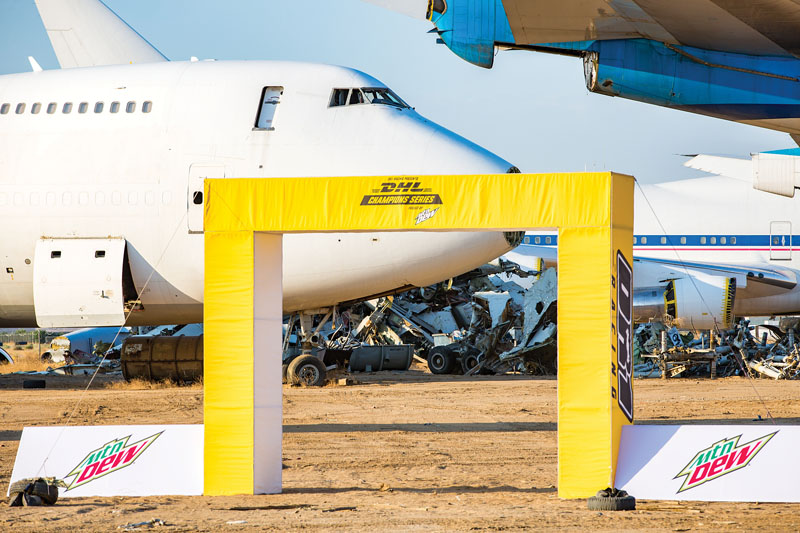
One of the many gates on the racecourse that the pilots had to navigate.
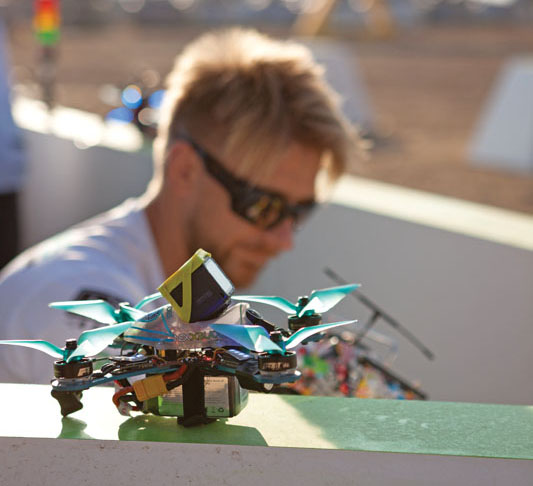
Drone set and ready!
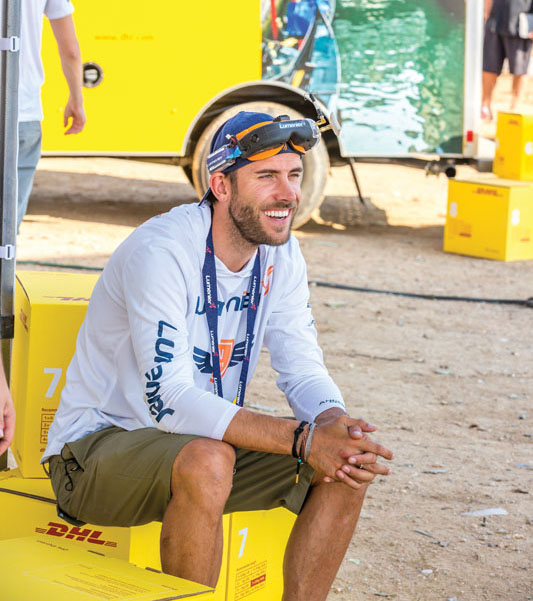
A Lumenier pilot takes a break while waiting for the next race.
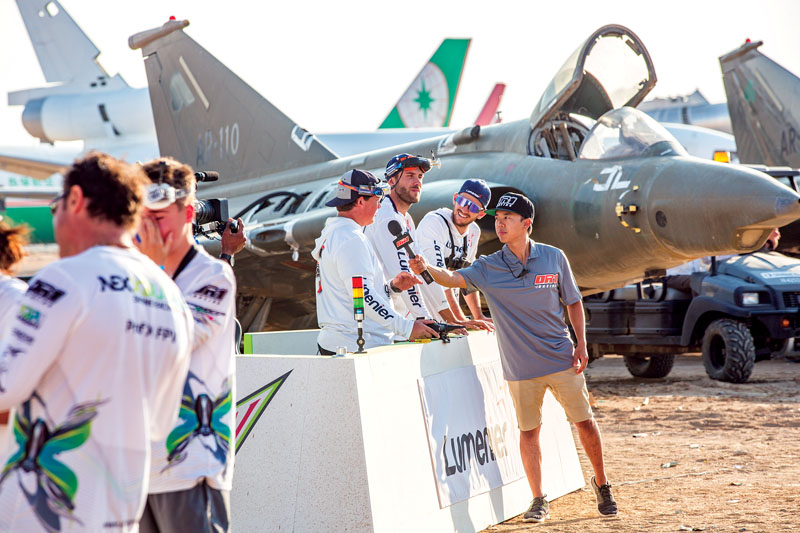
A quick interview with Team Lumenier before the next heat.
Prep Work
Each race day involves a ton of preplanning, which can include up to two prep days before the race (setting up and testing equipment), and each race day is followed by a wrap-up day. This means that each race can involve up to four long days of solid work. During that time, the racecourse needs to be laid out and tested, and camera angles have to be decided and set up. The relay equipment has to transmit video signals back to the video station, and the pilot video has to be uninterrupted and clear. Brad adds, “The linchpin to a successful drone race will always be the analog video feed. Though these pilots are pros when it comes to dealing with interference and signal loss, they cannot perform to the best of their ability if it is a constant issue. We went to great lengths to ensure that each location had a low noise floor [radio-frequency] environment and that any camera or audio equipment would not step on the 5.8GHz band we use for our video transmitters and receivers. Depending on the location and course layout, we used different antennae on our ground stations (high-gain directional or omnidirectional). Some of the courses have massive elevation changes, and we needed to run thorough tests to determine the best location for the ground stations in relation to the pilots and pit-stop landing pads. Analog video is a tricky beast, and it’s often quite difficult to isolate a problem.”
Shooting Schedule
We caught up with DR1 on the second leg of the race schedule at the Mojave Boneyard. For this leg, the crew starts its setup two days before the race. On day one, they transport all the equipment from Trona, starting their day at 5:00 a.m. When the last location is clean, they move everything over to the Mojave Boneyard and unload at the location, ready for day two.
Day two starts at 5:00 a.m., scouting out the location for the best camera setup. From there, the pilot station and all the camera tweaks are done, and then the crew moves on to set up the tents: one for the camera crew and control station, along with a pilot’s pit area. During that time, the teams run a practice race to make sure that the course is working as tweaks are made to the course and camera locations. By noon, most of the filming equipment and racecourse is ready to go, and the crew and racers take lunch. After lunch, they take some B roll and drone beauty shots along with other footage.
Day three is race day, and this is another early day for the crew. By 7:30 a.m., all the cameras and sound have been set up in the correct locations, along with any other required equipment. The aerial drone filming crew is set up and ready to fly. By 8:00 a.m., the main rounds are ready to fly and will be wrapped up by lunch—at least that is the hope. After lunch, they run the finals rounds so that all of it is over by 2:00 p.m., after which any extra B roll is shot along with any missing interviews or extra pilot/drone footage. By 4:00 p.m., the crew hopes to be heading back to the hotel.
Day four is another early start, and the crew wraps the location and removes the tents, pilot station, racecourse, and gates. After a final cleanup, the awards ceremony takes place and is filmed. Some behind-the-scenes footage is shot to document the move from Mojave to Los Angeles, where everyone will board a jet and head to Europe. There’s no doubt that this is a grueling shooting schedule for both the pilots and filming crew.
Race Rules
The five teams consist of three pilots, and during any heat, two pilots will fly at once but the same two pilots on a team can’t race back-to-back heats. These pilots will fly against pilots from another team to have four quads in each heat. Each pilot needs to finish the required number of laps while performing one battery swap in the pit lane. Any pilot missing the designated air gate is disqualified from the heat.
Each team races against the other teams once, for a total of five heats. Pilots are assigned points based on their finishing position, and the two top teams advance to the final rounds. The final rounds consist of three back-to-back heats, with the first team to win two out of three heats declared the winner. From there, the bottom four teams compete for the final race ranking, which is used to determine the teams’ seasonal points.
For the final championship race, the teams’ seasonal points determine their final ranking. The bottom four teams then race against their opponent three times per round. Teams that win two out of the three rounds advance to the next round. The same applies for the second round of racing between the two winning teams: The first team to win two out of three races advances to battle three rounds with the first-place team. After six races and travel around the world, these three rounds determine the winner.

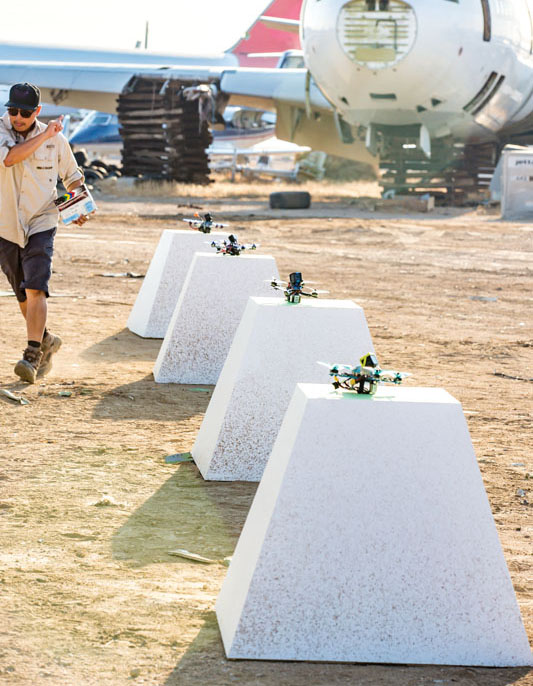
A quick slate is made at the starting line before the start of the race so that all the cameras
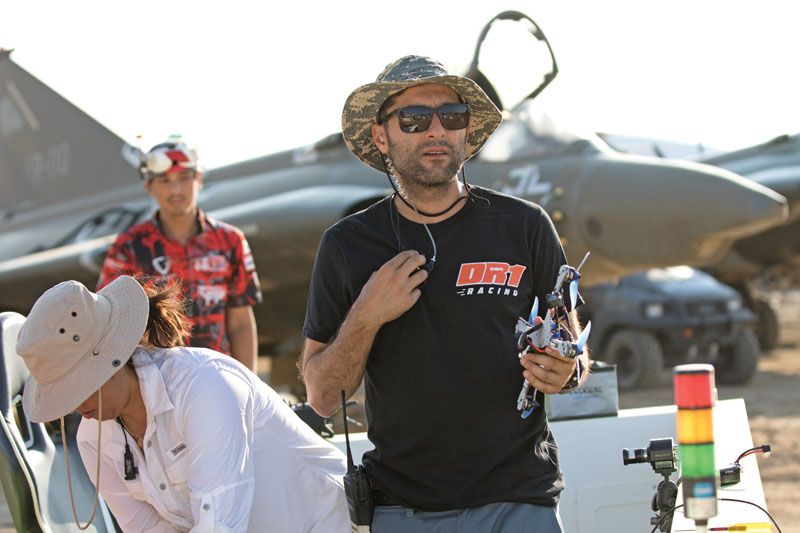
A DR1 official helps test out the video feed for the drones.
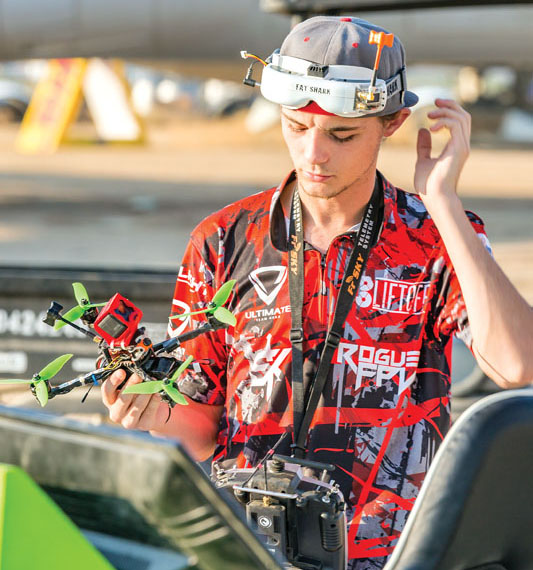
A Team Rebel pilot makes a final check on his drone. Everything has to be up and running before the start.
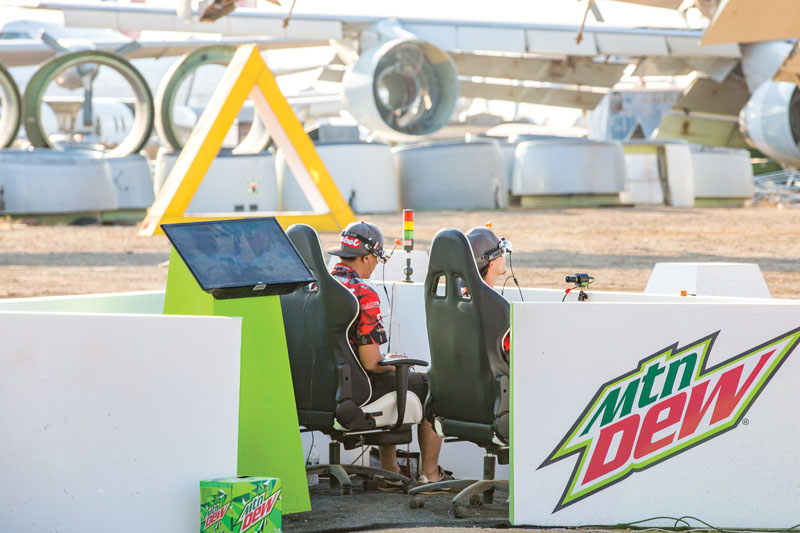
Team Rebel pilots in the middle of the race navigate their drones around the course. Their only connection to the drones are their goggles and the camera on the front of each drone.
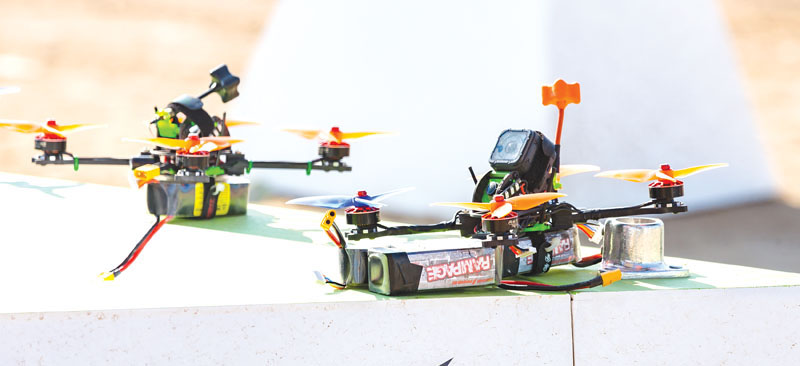
Two drones from Team Thunder Power sit ready for the heat. Notice the two extra battery packs nearby for the midrace exchange.
Our Day behind the Scenes
We spent race day with the cast and crew on location at the Mojave Boneyard to see what goes on during production for just one of these races, and I was impressed by the organization, professionalism, and skill set this group exhibits. By the time we arrived on the scene at 6:00 a.m., everything was already up and running, and the pilots were working on their aircraft in the pits, getting ready for the first round of racing. The camera crew had the pilot stations and all the gates, starting blocks, and cameras in position, along with sound and a ton of wires heading out from the control tent.
Within half an hour of our arrival, the pilot interviews started, and shortly after that, the first two teams headed to the pilot stations. As with any race, there is a certain amount of risk. With this one, the course is long and fast; pilots hit everything at full speed and are flying around and through a number of salvaged aircraft in different degrees of deterioration. All of the crew except for the pilots, their pitman, and two very brave camera operators were pushed back to the safety of the control tent to watch the race from there.
All four drones took off and headed out as the camera drone hovered overhead and then quickly followed them to the first gate. We watched the monitor with one camera feed from each drone, documenting the action as each drone flew through the course. As you can imagine, with all that scrap metal on the course, there were some casualties as pilots made the smallest miscalculations and struck into the ground—hard. At some point, all pilots had to land their aircraft and wait as their pitman made a quick battery change and got them back into the air. Because the pilots from each team fly at the same time, one would land on one lap, while the other waited for the next lap to make the battery change. There were some exciting moments as the pilots landed (which almost looked like a controlled crash) and the pitmen made the battery exchange.
The lap counters in the control tent told the pilots when it was time to land, and as soon as all the birds were on the ground, the filming crew jumped into action. Golf carts appeared and drove each pilot out to where their drone may have gone down for a quick retrieval. The judges determined who won that heat and which team took the victory. The mobile-camera team quickly interviewed the winners to get their reaction on film. The technicians made quick work of any adjustments needed on the equipment and cameras, making sure everything was ready for the next heat. Within 20 minutes, the next heat was up and running with the next two teams, while in the pits, any drones that had crashed in the previous round were repaired.
As you can imagine, with drones flying around all that metal and flying near an active airport, there were some video-relay issues after a few rounds of flying. After a few attempts at some quick fixes, lunch was called and the crew decided to rerun some of the heats that had been affected. This gave the techs time to work out the problems. After lunch, racing continued running along the same path until the final round. I was extremely impressed by how well everyone got back on track to finish up the day. The crew worked together as one, and it was quite amazing to watch.
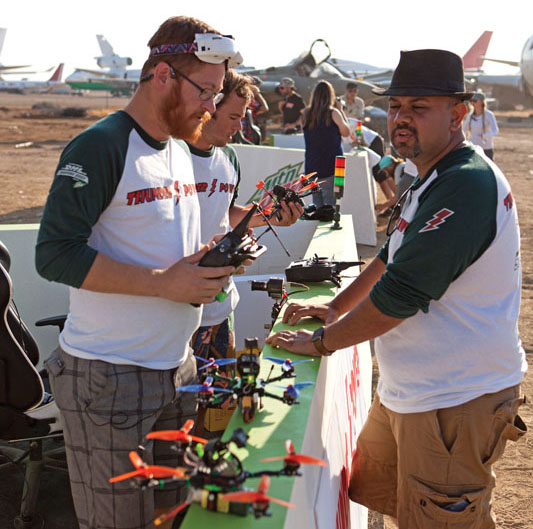
Team Thunder Power discusses strategy before the fray.
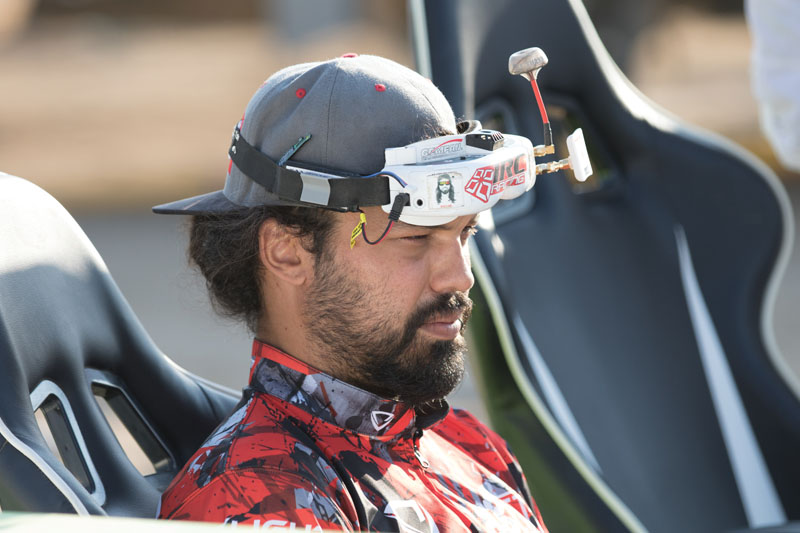
A brief moment of calm for a Team Rebel pilot before the start of the race.
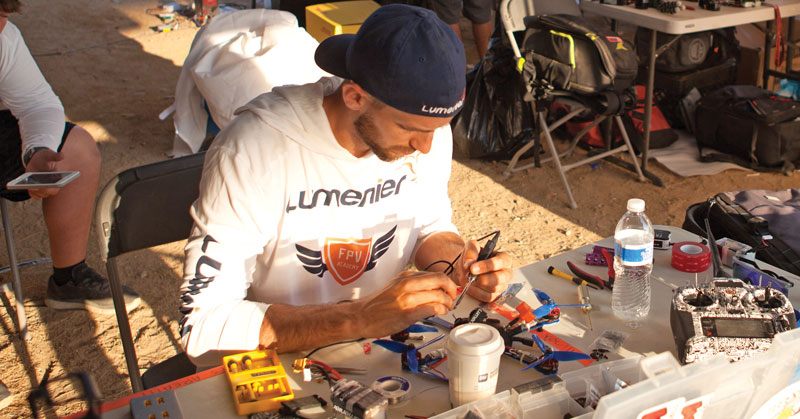
The busiest section is, of course, in the pits as all of the pilots help prepare for the next heat.
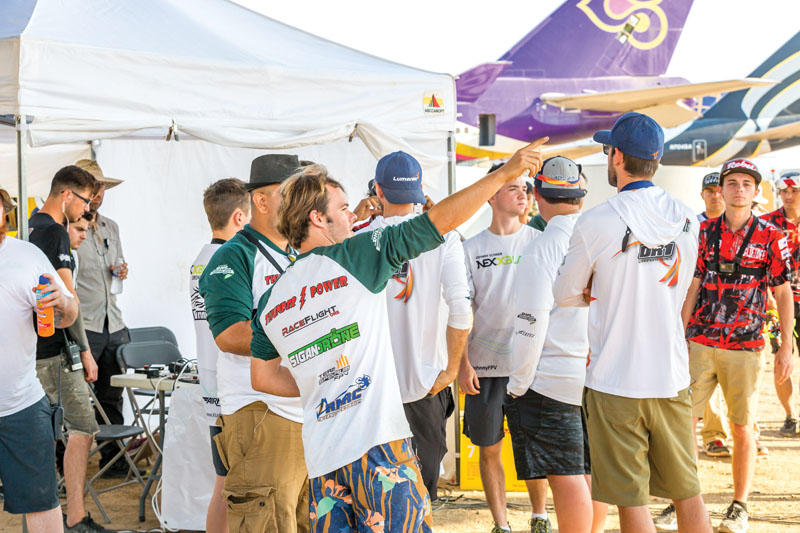
Many questions were asked during the pilots’ meeting early in the
day.
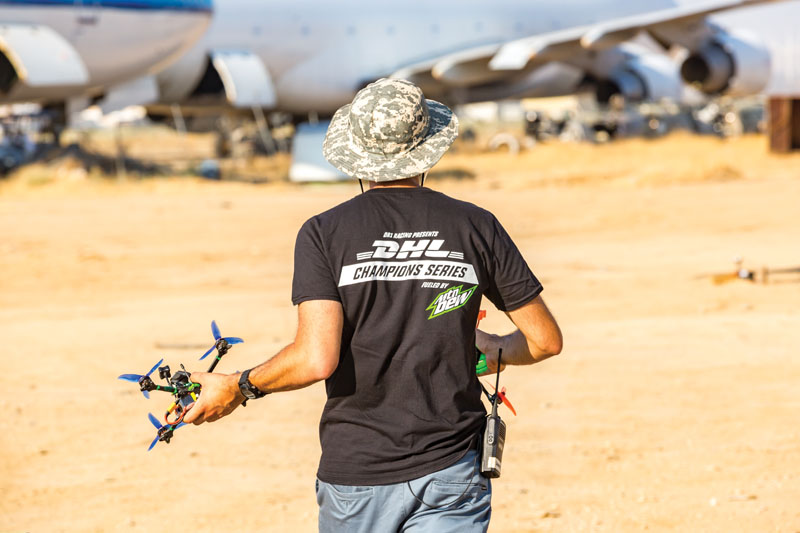
The film crew also helped out when they could.
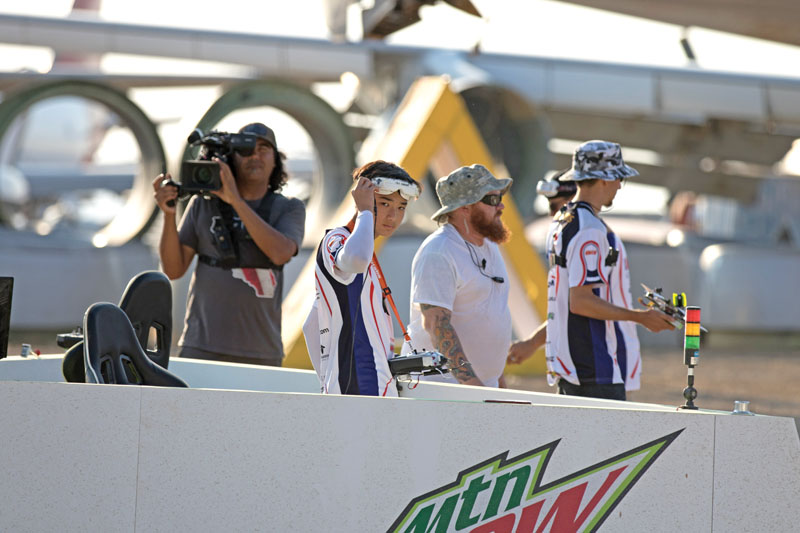
Everyone anxiously awaits the race results.
Final Thoughts
We can’t wait to see this series on television. Brad tell us, “The races will air on broadcast television in over 100 countries and 300 markets in late October, then in November and December. Here in the United States, the beIN network will air all six races, and CBS will air the finals on November 4 at 1:30 p.m. EST. In Europe, Eurosport will air the races across the continent, with Fox Sports airing the series in Asia.
“We are proud to be the first drone-racing series to air on national broadcast television, with CBS, reaching close to 99 percent of the households in the United States. Working alongside CBS, beIN, Eurosport, and Fox Sports, and then on Twitch.tv, allows DR1 to continue to be the global leader in drone racing.”
For more information, check out the DR1 website at dr1racing.tv.


